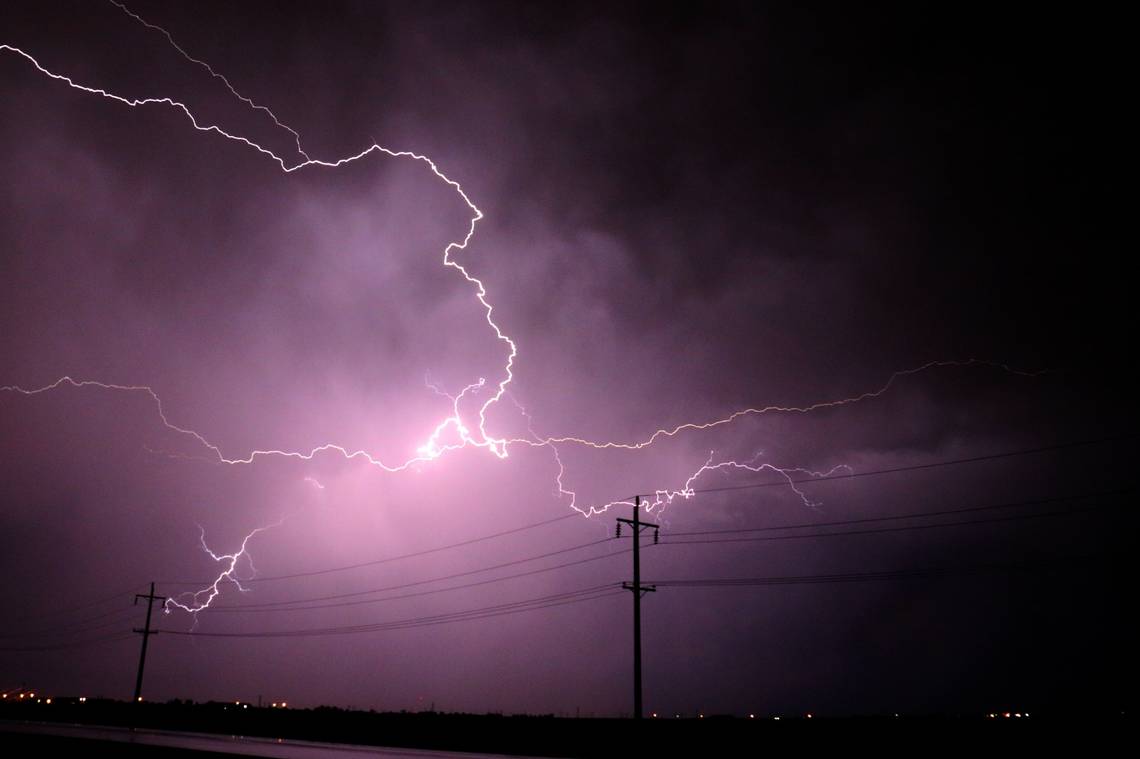Expect pea-sized hail (0.25 inches) and wind gusts of up to 40 mph.
“At 11:57 p.m., Doppler radar tracked strong thunderstorms along a line extending from Corral City to near Haslet to Lake Worth. Movement was east at 40 mph,” states the NWS. “Gusty winds could knock down tree limbs and blow around unsecured objects. Minor damage to outdoor objects is possible.”
Locations impacted by the warning include Fort Worth, Plano, Irving, Carrollton, Frisco, Denton, Lewisville, Flower Mound, Euless, Bedford, Grapevine, Haltom City, Keller, Coppell, Hurst, The Colony, Farmers Branch, Southlake, Watauga and Colleyville.
The NWS adds, “If outdoors, consider seeking shelter inside a building. A Severe Thunderstorm Watch remains in effect until 3 a.m. for north central Texas.”
This alert is in effect until Monday at 12:45 a.m.
How to react when facing a lightning hazard?
Lightning hits the United States approximately 25 million times annually. The majority of these strikes happen during the summer, causing around 20 fatalities each year, according to the NWS. The likelihood of lightning increases as a thunderstorm gets closer and reaches its highest point when the storm is directly overhead. This risk decreases as the storm moves away.
Here are tips on how to stay safe during a thunderstorm:
• To reduce the chance of being struck by lightning, when venturing outside, have a plan to get to a safer area.
• If the sky grows ominous and you hear thunder, seek out a safe place to take shelter.
• Once indoors, avoid touching corded phones, electrical equipment, plumbing, and windows and doors.
• Wait 30 minutes after the last lightning or thunder before going back outside.
If finding indoor shelter is not an option:
• Avoid open fields, hill peaks, or ridge tops.
• Avoid tall, isolated trees or other elevated objects. If you are in a forest, stick to areas with shorter tree cover.
• When in a group, space out to prevent the current from transferring between individuals.
• If you are camping in an open setting, set up camp in a valley, ravine, or other low spot. Bear in mind, a tent does not protect you from lightning.
• Stay away from water, wet items, and metal objects. Water and metal do not attract lightning but they are excellent conductors of electricity.
What to do in the rain on the road?
• Turn on your headlights — Even when it’s light outside, using headlights can improve visibility and alert other drivers to your presence.
• While on the road — Opt for the middle lanes and remain on higher ground. Rainwater tends to gather along the road edges.
• Steer clear of puddles — Driving into puddles or low areas of rainwater can cause vehicles to hydroplane or skid out of control.
• Don’t tail large vehicles closely — Trucks or buses can kick up a water spray that obstructs visibility.
• Avoid flooded areas — When encountering a flooded road, do a U-turn and head back. The strong currents from flash floods can pull drivers off roadways. Driving through deep water can also negatively affect a vehicle’s mechanical and electrical systems.
What is hydroplaning?
Hydroplaning is the term for when a vehicle begins sliding uncontrollably on wet roads.
This happens when water in front of the tire builds up faster than the vehicle’s weight can push water out of the way. The water pressure then causes the vehicle to rise and slide on a thin layer of water between the tires and the road, making the driver lose control. Hydroplaning is most commonly attributed to three factors:
1. Vehicle speed — When a vehicle’s speed increases, the tire-traction grip and ability to control the vehicle decreases. Drive at a reduced speed during wet weather.
2. Water depth — The deeper the water, the sooner a vehicle loses traction on the road. It doesn’t matter how deep the water is, even a thin layer can lead to hydroplaning.
3. Tire tread depth — Checking your tire tread before hitting the road is important, as low or no tread can lead to sliding.
In the event of your vehicle hydroplaning, here’s what to know:
• Ease off the accelerator — Step off the gas to slow down the vehicle until the tires find traction.
• Turn into the skid — Turning into the skid can help the vehicle’s tires realign to regain control.
• Make sure the tires reconnect with the road — During the skid, wait until the tires reconnect with the road and then gently straighten the wheels to regain control.
• Brake gently as needed — Brake normally if the vehicle has anti-lock brakes and pump brakes gently if in an older vehicle.
Source: The National Weather Service
